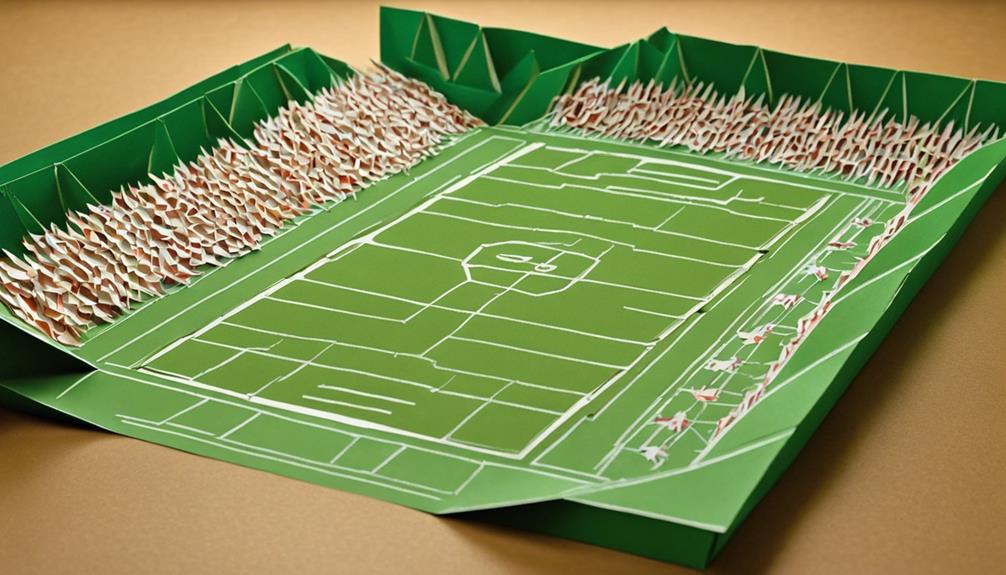General Rules of Six Man Football
So, you think six-man football is just like the regular version but with fewer players? Think again. The rules of this fast-paced game may surprise you with their unique twists and strategic challenges. From the field dimensions to the specialized player roles, there's a lot to unpack in the world of six-man football. Want to know more about how this dynamic sport differs from its traditional counterpart? Stay tuned for a breakdown of the general rules that govern six-man football and get ready to explore a whole new dimension of the game.
Field and Team Setup

When setting up for a game of six-man football, ensure that the field dimensions and team composition adhere to the specific rules governing this variant of the sport. The field for six-man football is typically 80 yards long and 40 yards wide, which is smaller than the standard 11-man football field. This size adjustment allows for a faster-paced and more high-scoring game, perfect for those who enjoy quick and dynamic gameplay.
Player formations in six-man football differ from the traditional 11-man game. In this variant, each team consists of six players on the field at a time, with three linemen and three backs. The linemen are usually center, guard, and tackle, while the backs include a quarterback, running back, and receiver. This setup creates a more open field, emphasizing speed, agility, and strategic play.
Understanding the field dimensions and player formations is crucial for success in six-man football. By mastering these aspects, you can adapt your gameplay to excel in this exciting and fast-paced version of the sport.
Scoring System and Timing
In six-man football, the scoring system and timing are structured to enhance the fast-paced and dynamic nature of the game, offering players and spectators an exciting experience. The scoring system in six-man football remains similar to the traditional 11-man game, with touchdowns worth six points. However, due to the smaller teams, high-scoring games are more common, making every point crucial for success. The timing aspect is also adjusted to suit the pace of the game, with shorter quarters to maintain the intensity throughout.
- Scoring System: Touchdowns are worth six points, and teams can earn additional points through conversions or field goals.
- Timing: Quarters are typically shorter to accommodate the faster gameplay and ensure an action-packed experience.
- Offense Tactics and Defense Strategies: Teams often employ creative offensive plays and aggressive defensive strategies to capitalize on the open field and fewer players, requiring quick thinking and adaptability.
Understanding the scoring system and timing in six-man football is essential for players and coaches to devise effective offense tactics and defense strategies for a competitive edge on the field.
Player Positions and Roles

Now shifting our focus to the intricacies of player positions and roles in six-man football, understanding the unique dynamics each player brings to the game is crucial for a team's success on the field. The quarterback in six-man football holds a pivotal role, responsible not only for passing but also for running plays efficiently due to the smaller number of players on the field. Quarterback responsibilities include making quick decisions, reading the defense, and accurately delivering the ball to receivers. Receivers in six-man football have a broader range of routes due to the open field, requiring quick bursts of speed and precise route running to create space for the quarterback to make successful passes. Understanding receiver routes and being able to adjust them on the go based on defensive coverage is key to executing effective passing plays. Each player's role in six-man football is crucial, and mastering quarterback responsibilities and receiver routes can greatly impact a team's offensive performance.
Special Rules and Adaptations
Understanding the special rules and adaptations in six-man football is essential for maximizing your team's strategic advantage on the field. In this fast-paced game, rule variations and adaptations play a crucial role in shaping both offensive and defensive strategies.
- Field Size: The field in six-man football is typically smaller than traditional 11-man football fields. This compact size requires players to cover more ground quickly, impacting offensive plays and defensive coverage.
- Eligible Receivers: In six-man football, all players on the field are eligible to catch a pass. This rule variation opens up a wide range of creative offensive strategies, allowing for unexpected plays and dynamic gameplay.
- Defensive Alignment: With fewer players on the field, defensive strategies need to be agile and adaptable. Teams must adjust their formations to counter the speed and versatility of the opposing offense effectively.
These rule variations and adaptations in six-man football create a dynamic and exciting environment where strategic thinking and quick decision-making are paramount for success.
Strategies and Gameplay Tactics

Exploring effective strategies and gameplay tactics is essential for achieving success in six-man football. When it comes to offensive plays, utilizing the speed and agility of your players is crucial. Consider incorporating spread formations to create mismatches against the defense, exploit open spaces, and capitalize on quick passes. On the defensive end, implementing various schemes such as the 3-2-1 defense can help cover the field effectively with fewer players, focusing on quick reactions and sound tackling.
| Offense | Defense |
|---|---|
| Spread Formations | 3-2-1 Defense |
| Quick Passes | Quick Reactions |
| Mismatches | Sound Tackling |
| Agility | Field Coverage |
In addition to strategic plays, mastering clock management is vital in six-man football. Efficient play calling, especially in critical moments, can make a significant impact on the outcome of the game. Remember, in this fast-paced game, every second counts, so make each play count towards your team's success.
Equipment and Safety Measures
To ensure the safety of players and maintain the integrity of the game, proper equipment and safety measures are paramount in six-man football. When it comes to equipment maintenance and injury prevention, there are key factors to consider:
- Regular Inspections: Conduct routine checks on helmets, pads, and other protective gear to ensure they are in good condition and provide adequate protection.
- Proper Fit: Ensuring that all players have equipment that fits correctly is essential in preventing injuries. Ill-fitting gear can increase the risk of harm during gameplay.
- Hydration and Rest: While not traditional equipment, staying properly hydrated and allowing for adequate rest are crucial safety measures. Dehydration and fatigue can lead to more frequent injuries on the field.
Frequently Asked Questions
Are There Any Restrictions on the Type of Cleats That Players Can Wear in Six Man Football?
When playing six-man football, you're free to wear cleats that enhance performance within safety guidelines. Cleat regulations exist to protect players and ensure fair play. Make wise footwear choices to boost your game.
Can a Player Who Has Already Scored a Touchdown Attempt to Kick the Extra Point Themselves?
Yes, a player who has scored a touchdown can attempt to kick the extra point themselves in six-man football. This player eligibility allows for scoring rules to be met with kicking restrictions lifted for this scenario.
Are There Any Specific Rules Regarding the Use of Trick Plays or Deceptive Tactics in Six Man Football?
So, you wanna know about trick play strategies and deceptive tactics in six-man football, huh? Well, while these can be fun to execute, remember to always play fair and uphold sportsmanship expectations.
How Are Tie Games Resolved in Six Man Football?
In six man football, tie games are resolved through overtime rules. Teams get a chance to score from the 15-yard line. If still tied after each team's possession, it continues until someone wins.
Are There Any Limitations on the Number of Players Who Can Line up in the Backfield on Offense in Six Man Football?
In six-man football, there are no limitations on the number of players who can line up in the backfield on offense. This flexibility allows for innovative offensive strategies and creative plays, making the game exciting and dynamic.






